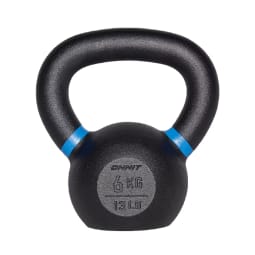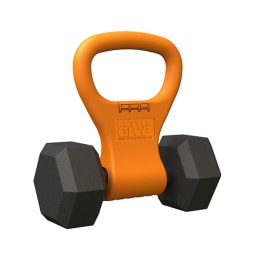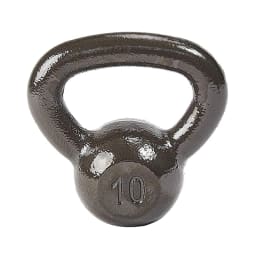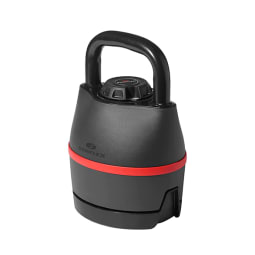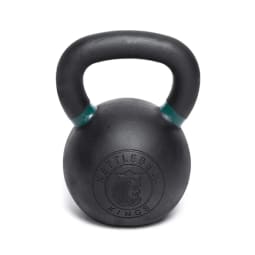Read on for expert insight into this home gym MVP from three certified personal trainers, plus our picks for the six best kettlebells for all your lifting needs. From squats to curls to presses, kettlebell variations allow you to challenge your muscles in different ways—and that promotes progress. Plus, some signature kettlebell moves, like kettlebell swings, can’t be comfortably replicated with a dumbbell. While both home gym staples share a similarly small footprint, kettlebells zig where dumbbells zag. “Kettlebells provide a change in weight distribution compared to a dumbbell,” says Bulay. “Due to the shape of a kettlebell and the varying ways to hold it, it’s possible to increase the difficulty of any physical movement during a workout.” It’s true: Holding the kettlebell by its base, its handle, or even upside down affects everything from difficulty level to how the muscle is being stressed. Bulay says that’s all thanks to physics and biomechanics: “Holding it in different areas changes the lever and momentum to provide either more or less difficulty and/or stability.” While not sold in sets, each kettlebell is color-coded according to weight. That makes it easy to grab the right weight even if you’re super-setting or moving quickly through circuits. Just over 400 reviewers give these kettlebells top marks for quality and value. This clamp features a simple design: open the handles, line up the dumbbell on the foam insert, close the handles, snap the latch, and you’re ready for a kettlebell workout (or pretty close to it). While the grip is similar to a kettlebell, the weight distribution is not. That means not every kettlebell exercise will work with the Gryp, and that’s especially true the heavier you go. Still, if your home gym already has dumbbells and you’re interested in basic kettlebell exercises, this might be worth a closer look. More than 6,000 reviewers seem pretty pleased with these adjustable kettlebells, though some customers did take issue with the plastic construction and straight handle, which may limit some exercises. Another word to the wise—the footprint isn’t excessively oversized, but people do comment on its taller height and oval shape. “For the home, I prefer quality vinyl or rubber-coated kettlebells to protect flooring and prevent rusting in some environments,” says Jamie Costello, MSC, vice president of fitness and sales at Pritikin Longevity Center. The vinyl coating leaves the handle clear for the best grip. Plus, different weights come in different colors, so you’ll always reach for the right one. Reviews are admittedly limited, but customers are pleased across the board. Another consideration is the recessed logo. Since it’s not unusual for kettlebells to come into contact with various body parts during certain exercises, a recessed logo means nothing is digging painfully into your wrist or forearm during a set. While these are an expensive choice, they do have a lifetime warranty. Plus, customers are exceedingly happy, giving these kettlebells an overall 4.8 rating. That’s largely because the instability that comes from bearing weight on one side of the body without a counterbalance is part of the training benefit—and part of the fun, explains Fischer. But if you’re looking to invest in multiple kettlebells, using a few different weight options will offer more versatility to your workout. “Instead of two kettlebells of the same weight, I would prefer someone invest in multiple weight loads that can be used with one or two arms,” says Costello. RELATED: Trying To Rev Up Your Metabolism? These Targeted Supplements Can Help “Beginners to kettlebell exercises should start out with a light kettlebell they can control,” advises Costello. “A good test is to try and pick up the kettlebell with the nondominant arm and raise to shoulder level 10 times with moderate effort. You can always go heavier, but it’s a bad idea to start out too heavy.” Just like dumbbells, you’ll use lighter kettlebells for smaller muscle groups—biceps, triceps—and heavier kettlebells for larger muscle groups—quads, back, shoulders. “Go lighter weight for the stability exercises and heavier for the dynamic and heart-rate-driven movements,” adds Fischer. Your best bet is to check out kettlebells in person to find an appropriate weight for the exercises you’re planning. Remember, you’ll want a lighter kettlebell for smaller muscle groups and something heavier to target big muscle groups. If you’re budgeting for a single kettlebell to start, keep it light. “Your first kettlebell should be light for practice and control,” says Costello. Eventually, it can become your warm-up tool. Still, if you have the space and the budget, an ideal setup for your home gym would include a few sets of dumbbells in addition to a couple of kettlebells of varying weights.









